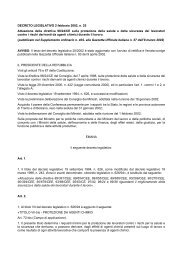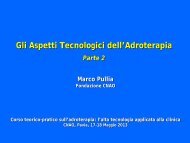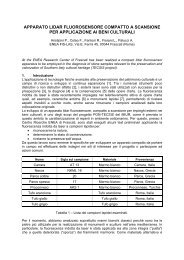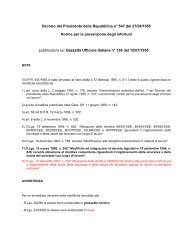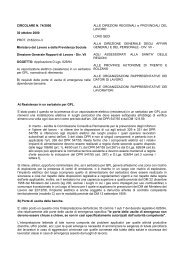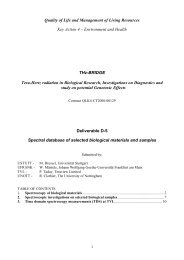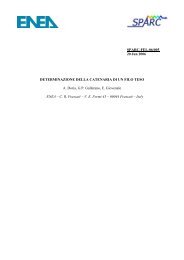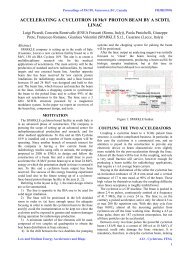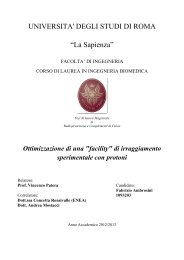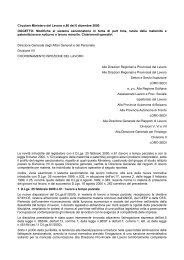Theory, Design and Tests on a Prototype Module of a Compact ...
Theory, Design and Tests on a Prototype Module of a Compact ...
Theory, Design and Tests on a Prototype Module of a Compact ...
Create successful ePaper yourself
Turn your PDF publications into a flip-book with our unique Google optimized e-Paper software.
82 5. RADIOFREQUENCY MEASUREMENT<br />
All this means that it is required a RF measurement able to acquire<br />
the relative electric field distributi<strong>on</strong> inside the cavities <str<strong>on</strong>g>and</str<strong>on</strong>g> this is<br />
possible using the bead pulling technique.<br />
Bead pulling is a perturbati<strong>on</strong> technique based <strong>on</strong> Slater’s theorem<br />
[36, 37]. With the help <strong>of</strong> a perturbing object (the bead) which travels<br />
al<strong>on</strong>g the axis <strong>of</strong> the multi-cell structure, the electric field distributi<strong>on</strong><br />
is determined in terms <strong>of</strong> phase variati<strong>on</strong> introduced by the bead. The<br />
multi-cell structure is driven at a fixed frequency that is the accelerating<br />
mode frequency.<br />
The Slater perturbati<strong>on</strong> theorem can be written as follows:<br />
f 2 = f 2 <br />
∆τ<br />
0 1 + α<br />
(µH2 − εE2 ) dτ<br />
<br />
V (µH2 + εE2 <br />
(5.12)<br />
) dv<br />
where α is a c<strong>on</strong>stant related to the particular perturbing object, the<br />
numerator represents the integrati<strong>on</strong> over the volume <strong>of</strong> the perturbing<br />
object <str<strong>on</strong>g>and</str<strong>on</strong>g> the denominator is equal to twice the average energy stored<br />
in the cavity U. If perturbati<strong>on</strong> is small the (5.12) can be simplified to<br />
∆f<br />
f0<br />
= α<br />
4U<br />
<br />
∆τ<br />
(µH 2 − εE 2 ) dτ. (5.13)<br />
This important relati<strong>on</strong> states that the change in frequency depends<br />
up<strong>on</strong> the integral <br />
∆τ (µH2 − εE2 ) dτ. And, if the perturbing object<br />
acts in a z<strong>on</strong>e where <strong>on</strong>ly the electric field is present in a significant<br />
way, the previous relati<strong>on</strong> simplifies again.<br />
Then, a procedure to measure the relative level <strong>of</strong> electric field in a<br />
multi-cell structure can be set up as follows:<br />
(1) A nyl<strong>on</strong> wire is stretched al<strong>on</strong>g the l<strong>on</strong>gitudinal axis <strong>of</strong> the<br />
structure <str<strong>on</strong>g>and</str<strong>on</strong>g> some mechanical tools <str<strong>on</strong>g>and</str<strong>on</strong>g> a motor allow the<br />
movement <strong>of</strong> the wire. Note that the wire itself modifies the<br />
res<strong>on</strong>ant frequency, since it is a dielectric 9 . Of course, a good<br />
alignment is needed between the wire <str<strong>on</strong>g>and</str<strong>on</strong>g> the axis <strong>of</strong> the cavities<br />
in order to have the same perturbati<strong>on</strong> in all the cavities.<br />
(2) A perturbing object (the bead) is put <strong>on</strong> the wire. The dimensi<strong>on</strong>s<br />
should be little enough to perturb as little as possible<br />
the field distributi<strong>on</strong>, but sufficient to give a good signal<br />
noise ratio. Using a cylindrical shape (a needle for example),<br />
the perturbati<strong>on</strong> acts <strong>on</strong> the axis <str<strong>on</strong>g>and</str<strong>on</strong>g> <strong>on</strong>ly the l<strong>on</strong>gitudinal<br />
comp<strong>on</strong>ent <strong>of</strong> the electric field is perturbed.<br />
(3) The network analyzer drives the structure at the res<strong>on</strong>ant frequency.<br />
The bead perturbs the electric field distributi<strong>on</strong> al<strong>on</strong>g<br />
the axis <str<strong>on</strong>g>and</str<strong>on</strong>g> this implies a change in frequency 10 <str<strong>on</strong>g>and</str<strong>on</strong>g> then,<br />
in the phase <strong>of</strong> the signal detected by the network analyzer.<br />
9 The nyl<strong>on</strong> wire lowers the frequency since it acts in a z<strong>on</strong>e where electric field<br />
is str<strong>on</strong>g <str<strong>on</strong>g>and</str<strong>on</strong>g>, as in a capacitor, it canalizes the field lines.<br />
10 Strictly speaking, the bead grows the frequency.







